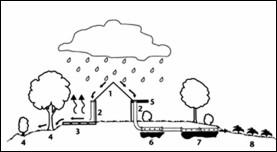 1. Roof runoff water 2. Drain pipes 3. Hot paved area cooled with surface runoff 4. Trees, grass, and shrubs irrigated with surface runoff 5. Overhang to shade windows from sun 6. Shrubs under overhang irrigated with perforated pipe placed on crushed stone for good drainage 7. Trees and shrubs irrigated with perforated pipe on crushed stone 8. Vegetables irrigated with runoff from end of pipe. |
Collecting rainwater from the roof is an age-old practice. Too often these days roof rainwater is just channeled into the ground via sewer or dry well. The old rain barrel was no joke, just commonsense conservation.
Roof water can be put to good use with just a little thought and planning. It can go from the drainpipe through a small pool and fountain. Or it can go over paved areas in hot, frost-free climates. It can be used first for these cooling purposes, and then again for irrigation. Perforated underground "Bemco" pipes can distribute it under tree roots and shrubbery beds. Finally the water can be directed to the vegetable garden. Clean waste water from sinks, bathtubs, washing machines and dishwashers can be used similarly for underground irrigation. This is called "grey water" and is fine as long as it is not overly contaminated with detergents.
In Shalimar, the unbelievably beautiful Persian Garden of Love in the Kashmir, water from the Himalaya mountains runs down a series of terraces. At each level, it irrigates the flower beds, charges the fountains, and fills the wading pools. Then it falls a few feet to the next terrace to work again.
Uncomplicated irrigation systems such as this which use directed surface runoff, pipes or crushed stone can save water bills, produce better trees and shrubs and possibly help with evaporative cooling. Under roof overhangs, plants normally receive no rainwater and so may suffer from drought, but using this kind of irrigation can help avoid sickly shrubs and high water bills.
A WORD OF CAUTION: If you plan to build a small ornamental pool or fountain, don’t use ground runoff water; it usually has silt and debris in it. Roof water, however, is clean and usable after it’s run through a screen. Goldfish or a thin coating of cooking oil will help control mosquito larvae.
Watch How to Install a Rain Barrel
Credit: www.mothersgarden.net




























